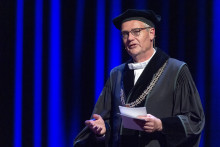In 2017, the University of Twente already set a target in line with the European and Dutch objective: all UT publications must be 100 per cent openly accessible by 2020. This means no required memberships, expensive subscriptions or pay walls for reading an article, but freely accessible research results for everyone.
UT not yet at 100 percent
In 2015, the UT achieved a level of only 30 percent open access, and by 2020 69 percent of UT publications is freely accessible. Still far from 100 percent. As Veldkamp knows, reality can be quite tasking. ‘Although we have an interest in making publicly funded research publicly accessible, many journals have a different – commercial – interest.’
Thanks to read-and-publish agreements between the universities and publishers, the number of journals in which open access can be published has grown in recent years to some 10 thousand. On an annual basis, such agreements cost the UT about 1.7 million euros. However, not all journals participate. Last year, the universities made a mega deal with Elsevier, but there are no such agreements with prestigious journals such as Science and Nature.
‘No, unless’ becomes ‘yes, unless’
The UT now thinks it can make a big step by adjusting the so-called Taverne procedure. This is the result of an amendment by then VVD member of parliament Joost Taverne, altering the Dutch Copyright Act in 2015. In a nutshell: research that has been fully or partially funded with public money may be published in open access after a ‘reasonable period of time’ by the author.
UT researchers were already using this to make closed publications open access, Drent explains. ‘But researchers had to do that themselves, starting six months after the original publication date. This form of opt-in involved a lot of hassle. For example, registering the publication for open access, drawing up, checking and signing a contract, consultation with our information specialists...’
The UT’s new procedure is like the changed Dutch organ donation act, according to the university librarian. ‘Opt-in becomes opt-out. In other words, we go from “no, unless” to “yes, unless”. If a scientist keeps track of their publications in Pure (the research information system used by the UT, ed.), LISA will ensure that the publication is also made available in open access. Unless you don’t want to, then you have to indicate that,’ explains Drent.
For the time being 100 per cent a utopia
This means that practically all articles that would otherwise remain behind a pay wall become open access after six months. ‘This includes articles published in Science or Nature, which would otherwise cost 10 thousand euros per publication,’ says Veldkamp. ‘With this adjustment, we can make a big step towards the target of 100 percent. And this will positively influence our way of working and cooperating.’
Nevertheless, there are factors that cause the 100 percent open access to remain a utopia for the time being. ‘The Taverne arrangement only applies to short publications, such as articles, chapters and contributions to conferences’, Veldkamp explains. ‘Longer publications such as textbooks are not covered – and these in particular often have a revenue model. Yes, I do have a problem with that. I’d rather see that money go to research.’ ‘But’, Drent nuances, ‘we are talking about some fifteen books a year, out of a total number of publications of some 2,800. More than 99 percent open access should certainly be feasible.’
No legal action
And what about the large publishers who see their revenue models crumble? The UT has no fear of legal action for now. ‘The Universities of The Netherlands (formerly VSNU, ed.) conducted a pilot in which publishers were extensively informed about the principles. This did not result in any legal action against the universities’, Drent assures.
Veldkamp sees publishers moving along with open access. ‘They have a certain position – a fairly strong one – in the whole thing. A publisher like Elsevier is not only offering more hybrid and full open access titles, but is also making the move from publications to data. That is the new gold and they want be ahead of the curve. We follow this trend closely and critically, because they offer us products that we value. The starting point should be that publicly funded research should in principle be available to the public without restrictions.’
The new policy will be discussed in the University Council today.







